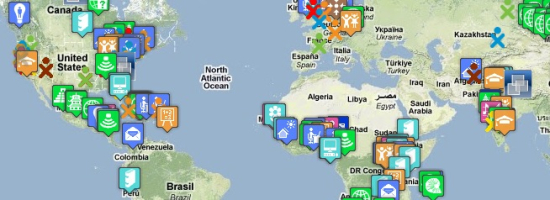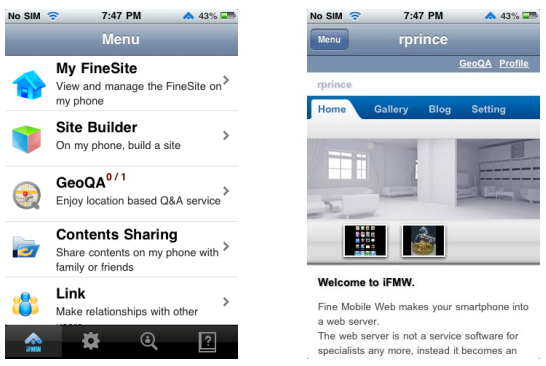 When we talked earlier about those trends and opportunities to look for in 2011, there was an unintentional slip on some specific topic areas. As we’ve talked about in terms of defining mobile ministry, its not so much the what of the technology that’s important, but how it is being utilized that will determine where to find solutions.
When we talked earlier about those trends and opportunities to look for in 2011, there was an unintentional slip on some specific topic areas. As we’ve talked about in terms of defining mobile ministry, its not so much the what of the technology that’s important, but how it is being utilized that will determine where to find solutions.
In our previous look into 2011, we said:
Mobile will continue to push towards the front of technology, health, educational, and policy conversations in 2011. What will be most interesting is the overlap. As we talked about some last year, contextualization and cross-functional knowledge will play a bigger part in understanding the role of mobile and the impacts to digital faith behaviors. Those individuals and groups that pollinate their mobile perspectives with multiple arenas will remain ahead of trends and applications.
With that background, let’s go towards some previously defined areas in mobile that are prime for seeing more or additional inroads by faith communities and initiatives.
Sections: Mission | Media | Discipleship/Education | Marketing/Analytics | Moment | Spiritual/Theological
Mobile in Mission
We defined mobile in mission as those efforts which look to contextualizing Gospel messages on local and global cultural scales. This happens in business as mission opportunities, education, and technology conversations in politics.
In 2011, we can look forward to more efforts to digitize content assets, increased visibility of mobile as a solution for community needs, and further experiments around mixed-media engagements which will finally lead to best practices and some consistent feedback.
What would be nice here is to see missionaries pick up on the excellent insights happening in the mhealth arena, there’s overlap here that helps mobile-led initiatives address community needs. And, as we’ve already talked about, mobile as a means of access and prevention will stay a hot topic.
Mobile in Media
When looking at mobile in media (creating and distributing visual/audio/text stories; or, building and implementing specifications and best practices around mobile multimedia opportunities), there’s more than just rebroadcasting content in a mobile-accessible format to consider – which is now understood to not be good enough.
Two veins of work are happening in visual story development that will be further defined this year – professionally produced projects and user generated works. The end-result of these works will fall easily into one of these two groups. While there’s opportunity in mobile TV, the key is still keeping content on-demand and open to stream/view on several devices by a single user. There’s no indication of a change in this space in terms of faith-based media.
Do also watch the political and industry space – the attention and conversations around subjects such as the Comcast/NBCU merger, Netflix, and net neutrality will have effects on media producers and consumers, in and beyond US shores. There’s room for niche offerings to do something disruptive in this space that changes the complexion of those conversations.
Mobile in Discipleship/Education
We’ve looked at mobile in discipleship and education in the past and have defined it in terms of those activities which facilitate curriculum development, address targeted and special education needs, and explore new styles of learning made possible by mobile technology.
Tablets are definitely in the plans for many educators, and the work that Fraser Speirs is doing should spark others to experiment in this space. Consider here also that tablets are the big techie item this year, so it might be another year until successes with them become notable stories.
We’ll be keeping an eye on how tablet uses flow into the smartphone crowd. There a better addressable crowd (aka more people) with smartphones than with tablets, and what can happen here should point to how education continues to adapt and change to being digital-first for more than just simple communication.
Teaching by knowledge mapping and pushing story development by mobile is growing here as well. What that looks like consistently is another question that this year’s body of work can answer.
Mobile Marketing/Analytics
When looking at mobile in marketing and analytics, we can be quick to just look at the produced product. But, I want to caution that its not just in the product that’s the whole story. We defined this area to also include search engine optimization, security, access, local media channel development, and then the use of mobile applications alongside and independent of broadcast channels.
So again, a mobile application is not a strategy, so how you measure the success of a mobile engagement is a nut that’s got to be cracked. In 2011, we’ll see solutions in this space, though the smaller, efective ones will be bought out and rolled into some of the longer time entrants (Demand Media, Google, etc.).
Look forward to software development becoming easier for non-developers (more efforts like Google’s App Inventor and Nokia’s Ovi Publish), and discoverability being key to attracting and keeping relevant users through better analytic tools (Google Analytics, Apple’s iAd, or other noted mobile marketing tools).
Personalization and recommendation engines are the major trends here to look for.
Mobile in Moment
When looking at mobile in moment for 2011, we simply ask the question of what happens with the mobile when in your personal space?
Yes, there are going to be releases of new and updated Bible software packages (we’ve already seen Accordance, and Olive Tree 5 is right around the corner). This also is the year where we’ll see a significant break in Bible software – that is, some companies will target academic/high-end learners only with deeper content offerings, while others will go the route of simpler content stores and increased emphasis around user experiences, sharing, and connecting content to communities. Companies that straddle the fence here will have a hard time keeping viable marketshare.
The move to digital-first is all but happening, and we’ll see more of this individually as new authors and publishers take advantage of their existing social networks and tools like Lulu. Traditional publishing is far from going away, but they’ve already got their call to move to the future (some moving faster than others).
SMS/MMS will remain high on the usage side Mobile IM will not be eating into that in any major fashion. We might have seen the plateau for BlackBerry Messenger (BBM) in some of RIM’s primary markets – though still growing well in Latin and South America. The cost of mobile devices continues to decline, and we might see a few more plays like Movirtu in developing markets, adding to the already stout 5 billion mobile phone subscriptions.
Will we see a different take on Biblical engagement with gaming this year in mobile? I think so, and it might come from the folks that do Bible Navigator X given their work already with a popular gaming platform.
Spiritual Implications
If people can’t see what God is doing, they stumble all over themselves; But when they attend to what he reveals, they are most blessed.
Where there is no prophecy, the people cast off restraint, but happy are those who keep the law.
(Message and NRSV, Proverbs 29:18)
Lastly, in looking at the spiritual implications present within mobile (theological constraints/precedents; psychological/cultural effects of mobile vs. other personal/connected technology media elements), we will continue to acceptance of some practices such as SMS for alerts, checking into social networks to know what’s going on in your local communities, etc. But, we will also see more communities push back against the instantaneous nature of mobile and social web connections by creating different rules around use and interpretation. I wonder about the effect of the research and lives of people like David Noble and Gary Chapman and if we will learn from their foresight.
Questions around contemplative moments, accountability with public-facing persons, and censorship will drive many to want to better associate technological hardship as a spiritual suffering. If you will, the term “technological fast” or “Facebook fasting” will enter the vocabulary.
As with other times in our history where knowledge and understanding has increased, the rise of mobile, and behaviors because of mobile will challenge methods and doctrines of faith. Some of these questions – such as the viability and validity of virtual fellowships – will come to healthy, if not hard to receive, conclusions for some.
So there you have it, a deeper look at what is in the ground towards happening in 2011. Some items pose more questions than answers, and at this point in understanding mobile ministry, that’s to be expected. The key here is that we’ve got a lens to determine if we are making progress or not – and in the view of moving from one year to another, that’s always a good thing.
 QR Code Holiday Campaign by the Austrian Postal Service
QR Code Holiday Campaign by the Austrian Postal Service The MMM Mobile Web Server Experiment
The MMM Mobile Web Server Experiment





 Wes Allen, who penned the post
Wes Allen, who penned the post 

